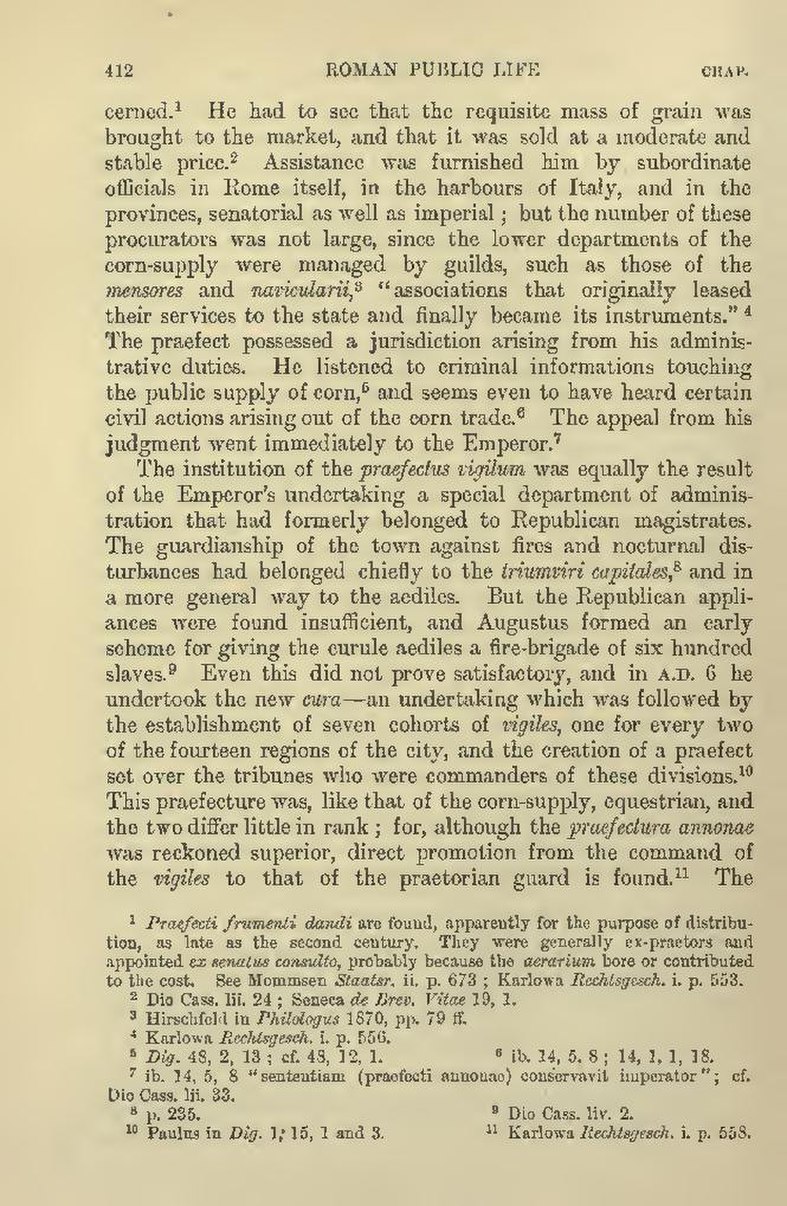- cerned.[1] He had to see that the requisite mass of grain was
brought to the market, and that it was sold at a moderate and stable price.[2] Assistance was furnished him by subordinate officials in Rome itself, in the harbours of Italy, and in the provinces, senatorial as well as imperial; but the number of these procurators was not large, since the lower departments of the corn-supply were managed by guilds, such as those of the mensores and navicularii,[3] "associations that originally leased their services to the state and finally became its instruments."[4] The praefect possessed a jurisdiction arising from his administrative duties. He listened to criminal informations touching the public supply of corn,[5] and seems even to have heard certain civil actions arising out of the corn trade.[6] The appeal from his judgment went immediately to the Emperor.[7]
The institution of the praefectus vigilum was equally the result of the Emperor's undertaking a special department of administration that had formerly belonged to Republican magistrates. The guardianship of the town against fires and nocturnal disturbances had belonged chiefly to the triumviri capitales,[8] and in a more general way to the aediles. But the Republican appliances were found insufficient, and Augustus formed an early scheme for giving the curule aediles a fire-brigade of six hundred slaves.[9] Even this did not prove satisfactory, and in A.D. 6 he undertook the new cura—an undertaking which was followed by the establishment of seven cohorts of vigiles, one for every two of the fourteen regions of the city, and the creation of a praefect set over the tribunes who were commanders of these divisions.[10] This praefecture was, like that of the corn-supply, equestrian, and the two differ little in rank; for, although the praefectura annonae was reckoned superior, direct promotion from the command of the vigiles to that of the praetorian guard is found.[11] The
- ↑ Praefecti frumenti dandi are found, apparently for the purpose of distribution, as late as the second century. They were generally ex-praetors and appointed ex senatus consulto, probably because the aerarium bore or contributed to the cost. See Mommsen Staatsr. ii. p. 673; Karlowa Rechtsgesch. i. p. 553.
- ↑ Dio Cass. lii. 24; Seneca de Brev. Vitae 19, 1.
- ↑ Hirschfeld in Philologus 1870, pp. 79 ff.
- ↑ Karlowa Rechtsgesch. i p. 556.
- ↑ Dig. 48, 2, 13; cf. 48, 12, 1.
- ↑ ib. 14, 5, 8; 14, 1, 1, 18.
- ↑ ib. 14, 5, 8 "sententiam (praefecti annonae) conservavit imperator"; cf. Dio Cass. lii. 33.
- ↑ p. 235.
- ↑ Dio Cass. liv. 2.
